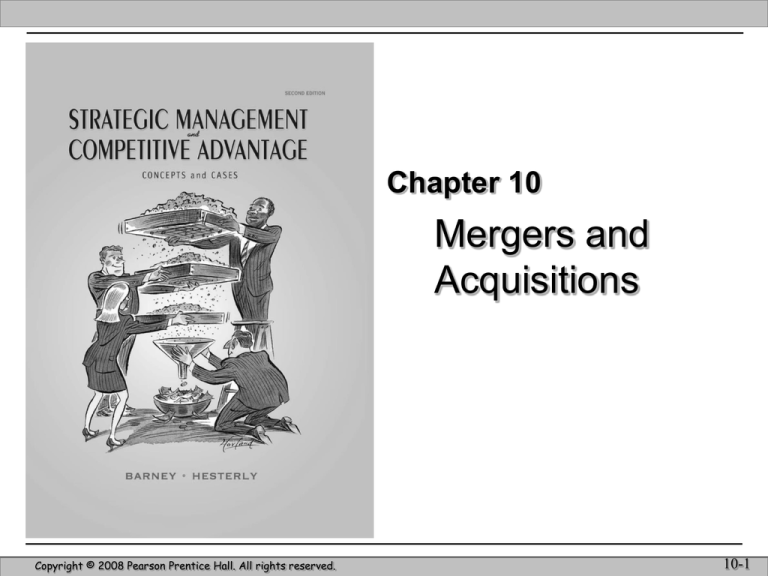
Chapter 10
Mergers and
Acquisitions
Copyright © 2008 Pearson Prentice Hall. All rights reserved.
10-1
Mergers
Mergersand
& Acquisitions
Acquisitions
The Strategic Management Process
External
Analysis
Mission
Strategic
Choice
Objectives
Strategy
Implementation
Competitive
Advantage
Which Businesses
to Enter?
Internal
Analysis
Corporate Level
Strategy
• Vertical Integration
• Diversification
Mode of Entry?
• Strategic Alliances
• Mergers &
Acquisitions
Copyright © 2008 Pearson Prentice
Hall. Management
All rights reserved.
Strategic
& Competitive
Advantage – Barney & Hesterly
10-2
2
Mergers
Mergersand
& Acquisitions
Acquisitions
Logic of Corporate Level Strategy Applies
Corporate level strategy should create value:
1) such that the value of the corporate whole increases
2) such that businesses forming the corporate whole
are worth more than they would be under
independent ownership
3) that equity holders cannot create through
portfolio investing
Copyright © 2008 Pearson Prentice
Hall. Management
All rights reserved.
Strategic
& Competitive
Advantage – Barney & Hesterly
10-3
3
Mergers
Mergersand
& Acquisitions
Acquisitions
Mergers & Acquisitions Defined
Mergers
• two firms are combined on
a relatively co-equal basis
Acquisitions
• one firm buys another
firm
• the words are often used interchangeably even
though they mean something very different
• merger sounds more amicable, less threatening
Copyright © 2008 Pearson Prentice
Hall. Management
All rights reserved.
Strategic
& Competitive
Advantage – Barney & Hesterly
10-4
4
Mergers
Mergersand
& Acquisitions
Acquisitions
Mergers & Acquisitions Defined
Mergers
• parent stocks are usually
retired and new stock issued
• name may be one of the
parents’ or a combination
• one of the parents usually
emerges as the dominant
management
Copyright © 2008 Pearson Prentice
Hall. Management
All rights reserved.
Strategic
& Competitive
Acquisitions
• can be a controlling
share, a majority, or
all of the target firm’s
stock
• can be friendly or
hostile
• usually done through
a tender offer
Advantage – Barney & Hesterly
10-5
5
Mergers
Mergersand
& Acquisitions
Acquisitions
Do Mergers and Acquisitions Create Value?
The Logic
Unrelated M&A Activity
• there would be no expectation of value creation
due to the lack of synergies between businesses
• there might be value creation due to efficiencies
from an internal capital market
• there might be value creation due to the exploitation
of a conglomerate discount
• a corporate raider who buys and restructures firms
Copyright © 2008 Pearson Prentice
Hall. Management
All rights reserved.
Strategic
& Competitive
Advantage – Barney & Hesterly
10-6
6
Mergers
Mergersand
& Acquisitions
Acquisitions
Mergers & Acquisitions Defined
Types of M&A Activity
FTC
Categories
Vertical
Horizontal
» suppliers or customers
» competitors
Related
Product Extension » complementary products
Market Extension » complementary markets
Unrelated
Conglomerate
Copyright © 2008 Pearson Prentice
Hall. Management
All rights reserved.
Strategic
& Competitive
» everything else
Advantage – Barney & Hesterly
10-7
7
Mergers
Mergersand
& Acquisitions
Acquisitions
Do Mergers and Acquisitions Create Value?
The Logic
Related M&A Activity
• value creation would be expected due to
synergies between divisions
• economies of scale
• economies of scope
• transferring competencies
• sharing infrastructure, etc.
Copyright © 2008 Pearson Prentice
Hall. Management
All rights reserved.
Strategic
& Competitive
Advantage – Barney & Hesterly
10-8
8
Mergers
Mergersand
& Acquisitions
Acquisitions
Do Mergers and Acquisitions Create Value?
The Empirical Evidence
Research is based on stock market reaction to the
announcement of M&A activity
• this reflects the market’s assessment of the
expected value of the merger or acquisition
• these studies look at what happens to the price
of both the acquirer’s stock and the target’s stock
• thus, we can see who is capturing any expected
value that may be created
Copyright © 2008 Pearson Prentice
Hall. Management
All rights reserved.
Strategic
& Competitive
Advantage – Barney & Hesterly
10-9
9
Mergers
Mergersand
& Acquisitions
Acquisitions
Do Mergers and Acquisitions Create Value?
The Empirical Evidence
M&A Activity creates value, on average, as follows:
Acquiring
Firms
Target
Firms
• no value created
• value increases by
about 25%
• related M&A activity creates more value than
unrelated M&A activity
M&A activity creates value, but target firms capture it
Copyright © 2008 Pearson Prentice
Hall. Management
All rights reserved.
Strategic
& Competitive
Advantage – Barney & Hesterly
10-10
10
Mergers
Mergersand
& Acquisitions
Acquisitions
Do Mergers and Acquisitions Create Value?
Expected versus Operational Value
April 2000: Wells Fargo offers to acquire First Security Bank
for about $3 billion
Expected
Operational
The Deal:
Stock values were:
Wells Fargo: $43.69
First Security: $15.50
.355 shares of WF for each
share of FS stock
Wells Fargo: down $0.25 to $39.50
First Security:
up $1.19 to $13.38
Copyright © 2008 Pearson Prentice
Hall. Management
All rights reserved.
Strategic
& Competitive
Stock Price
12/1999 $40.44
12/2000 $56.69
12/2001 $43.60
12/2002 $46.87
12/2003 $58.89
12/2004 $62.15
Advantage – Barney & Hesterly
Market Cap.
$65.7 B
$95.2 B
$74.0 B
$82.0 B
$100.0 B
$105.0 B
10-11
11
Mergers
Mergersand
& Acquisitions
Acquisitions
Why is M&A Activity So Prevalent?
If managers know that acquiring firms do not
capture any value from M&A’s, why do they
continue to merge and acquire?
Survival
Free Cash
Flow
• avoid competitive disadvantage
• avoid scale disadvantages
• cash generating, normal return investment
Copyright © 2008 Pearson Prentice
Hall. Management
All rights reserved.
Strategic
& Competitive
Advantage – Barney & Hesterly
10-12
12
Mergers
Mergersand
& Acquisitions
Acquisitions
Why is M&A Activity So Prevalent?
If managers know that acquiring firms do not
capture any value from M&A’s, why do they
continue to merge and acquire?
Agency
Problems
• managers benefit from increases in size
Managerial
Hubris
• managers believe they can beat the odds
• managers benefit from diversification
Copyright © 2008 Pearson Prentice
Hall. Management
All rights reserved.
Strategic
& Competitive
Advantage – Barney & Hesterly
10-13
13
Mergers
Mergersand
& Acquisitions
Acquisitions
Why is M&A Activity So Prevalent?
If managers know that acquiring firms do not
capture any value from M&A’s, why do they
continue to merge and acquire?
• some M&A activity does generate
above normal profits (expected and
operational over the long run)
Above Normal
Profits
• proposed M&A activity may satisfy
the logic of corporate level strategy
• managers may see economies that
the market can’t see
Copyright © 2008 Pearson Prentice
Hall. Management
All rights reserved.
Strategic
& Competitive
Advantage – Barney & Hesterly
10-14
14
Mergers
Mergersand
& Acquisitions
Acquisitions
Competitive Advantage
Can an M&A strategy generate sustained
competitive advantage?
Yes, if managers’ abilities meet VRIO criteria
1
Managers may be good at recognizing & exploiting
potentially value-creating economies with other firms
2
Managers may be good at doing ‘deals’
3
Managers may be good at both
Copyright © 2008 Pearson Prentice
Hall. Management
All rights reserved.
Strategic
& Competitive
Advantage – Barney & Hesterly
10-15
15
Mergers
Mergersand
& Acquisitions
Acquisitions
Competitive Advantage
Recognizing and Exploiting Economies of Scope
Private Economies
• Firm C’s recognized
value is $10,000
Firm A
Firm C
Firm B
Bidders
Target
Copyright © 2008 Pearson Prentice
Hall. Management
All rights reserved.
Strategic
& Competitive
• Firm A sees value
of $12,000 in Firm C
• Firm A can earn a
profit of $2,000
only if the economy
remains private
Advantage – Barney & Hesterly
10-16
16
Mergers
Mergersand
& Acquisitions
Acquisitions
Competitive Advantage
Recognizing and Exploiting Economies of Scope
Costly-to-Imitate
Economies
Firm A
Firm C
Firm B
Bidders
Target
Copyright © 2008 Pearson Prentice
Hall. Management
All rights reserved.
Strategic
& Competitive
• if the economy
between A & C
is costly to imitate,
it doesn’t matter
if other firms know
• Firm A can still earn
a $2,000 profit
Advantage – Barney & Hesterly
10-17
17
Mergers
Mergersand
& Acquisitions
Acquisitions
Competitive Advantage
Recognizing and Exploiting Economies of Scope
Unexpected
Economies
• Firm C has a market
value of $10,000
Firm A
Firm C
• Firm C turns out to be
worth $12,000
Firm B
Bidders
• Firm A buys Firm C
for $10,000
Target
Copyright © 2008 Pearson Prentice
Hall. Management
All rights reserved.
Strategic
& Competitive
Advantage – Barney & Hesterly
10-18
18
Mergers
Mergersand
& Acquisitions
Acquisitions
Competitive Advantage
Doing the Deal
Search for
Rare Economies
Limit Information
to Other Bidders
Seek Thinly
Traded Markets
Close the
Deal Quickly
Bidding Firm’s
Perspective
Limit Information
to the Target
Avoid Bidding
Wars
Copyright © 2008 Pearson Prentice
Hall. Management
All rights reserved.
Strategic
& Competitive
Advantage – Barney & Hesterly
10-19
19
Mergers
Mergersand
& Acquisitions
Acquisitions
Competitive Advantage
Doing the Deal
Seek Information
from Bidders
Target Firm’s
Perspective
Invite Other Bidders to
Join in Bidding Contest
Delay, But Do Not
Stop the Acquisition
Copyright © 2008 Pearson Prentice
Hall. Management
All rights reserved.
Strategic
& Competitive
Advantage – Barney & Hesterly
10-20
20
Mergers
Mergersand
& Acquisitions
Acquisitions
Implementation Issues
Structure, Control, and Compensation
M&A activity requires responses to these issues:
• m-form structure is typically used
• management controls & compensation policies
are similar to those used in diversification strategies
Managers must decide on the level of integration:
• target firm may remain somewhat autonomous
• target firm may be completely integrated
Copyright © 2008 Pearson Prentice
Hall. Management
All rights reserved.
Strategic
& Competitive
Advantage – Barney & Hesterly
10-21
21
Mergers
Mergersand
& Acquisitions
Acquisitions
Implementation Issues
Cultural Differences
• high levels of integration require greater cultural
blending
• cultural blending may be a matter of:
• combining elements of both cultures
• essentially replacing one culture with the other
• integration may be very costly, often unanticipated
• the ability to integrate efficiently may be a source
of competitive advantage
Copyright © 2008 Pearson Prentice
Hall. Management
All rights reserved.
Strategic
& Competitive
Advantage – Barney & Hesterly
10-22
22
Mergers
Mergersand
& Acquisitions
Acquisitions
International Issues
Government Policy
• governments may constrain ownership by
foreign firms
• governments may restrict repatriation of profits
• government labor policy may limit a firm’s ability
to apply management practices to target firm
Copyright © 2008 Pearson Prentice
Hall. Management
All rights reserved.
Strategic
& Competitive
Advantage – Barney & Hesterly
10-23
23
Mergers
Mergersand
& Acquisitions
Acquisitions
International Issues
Cultural Issues
Individualism
Social Orientation
Collectivism
Respect
Power Orientation
Tolerance
Acceptance
Uncertainty Orientation
Avoidance
Aggressive
Goal Orientation
Passive
Long-term
Time Orientation
Short-term
(Hofstede, 1980)
Copyright © 2008 Pearson Prentice
Hall. Management
All rights reserved.
Strategic
& Competitive
Advantage – Barney & Hesterly
10-24
24
Mergers
Mergersand
& Acquisitions
Acquisitions
Summary
M&A activity is a mode of entry for vertical
integration and diversification strategies
A firm’s M&A strategy should satisfy the
logic of corporate level strategy
M&A activity can create economic value at
announcement, but target firms usually capture
that value
M&A activity can create value over the long term
for the acquiring firm
Copyright © 2008 Pearson Prentice
Hall. Management
All rights reserved.
Strategic
& Competitive
Advantage – Barney & Hesterly
10-25
25






